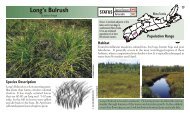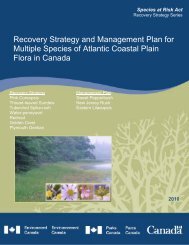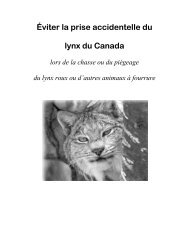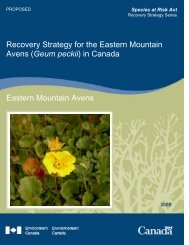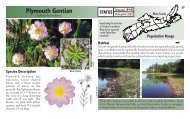Healthy Lakes and Wetlands For Tomorrow - Species at Risk
Healthy Lakes and Wetlands For Tomorrow - Species at Risk
Healthy Lakes and Wetlands For Tomorrow - Species at Risk
You also want an ePaper? Increase the reach of your titles
YUMPU automatically turns print PDFs into web optimized ePapers that Google loves.
Elimin<strong>at</strong>e pesticide <strong>and</strong> herbicide use <strong>and</strong> keep your family <strong>and</strong> environment healthy.<br />
Chemical free gardens contain a diversity of n<strong>at</strong>ural pred<strong>at</strong>ors th<strong>at</strong> will keep down most insect outbreaks.<br />
Pesticides have many unforeseen impacts <strong>and</strong> can kill beneficial insects, amphibians, <strong>and</strong> other wildlife.<br />
Pesticides <strong>and</strong> fertilizer runoff from lawns <strong>and</strong> gardens expose our family, pets, <strong>and</strong> wildlife to chemicals,<br />
<strong>and</strong> can end up in the w<strong>at</strong>er we rely on to drink. Elimin<strong>at</strong>e the need for these products by practicing<br />
n<strong>at</strong>ural pest management techniques (see resources).<br />
Wh<strong>at</strong>’s So Bad About a Lawn<br />
Lawns are not ideal around the lake shoreline. When n<strong>at</strong>ural veget<strong>at</strong>ion surrounds a lake only 10%<br />
of the rainw<strong>at</strong>er flows into the w<strong>at</strong>er body. Lawns retain much less w<strong>at</strong>er <strong>and</strong> allow up to 55% of<br />
rainw<strong>at</strong>er to directly enter the lake <strong>and</strong> with it fertilizers, nutrients, <strong>and</strong> chemicals.<br />
Lawns need to be weeded, mowed, <strong>and</strong> w<strong>at</strong>ered - the less lawn you have, the more time you have<br />
to relax. It may appear th<strong>at</strong> your lawn is not having much of an impact but many lawns around a<br />
lake may result in decreased w<strong>at</strong>er quality <strong>and</strong> loss of wildlife habit<strong>at</strong>. So relax, get rid of your lawn<br />
<strong>and</strong> let n<strong>at</strong>ure do the work for you!<br />
Invasive Alien <strong>Species</strong><br />
• Are animals <strong>and</strong> plants th<strong>at</strong> have become<br />
established in areas outside their n<strong>at</strong>ural<br />
range <strong>and</strong> have the potential to harm the<br />
environment, economy <strong>and</strong>/or society.<br />
• Thre<strong>at</strong>en our n<strong>at</strong>ural biodiversity by displacing<br />
n<strong>at</strong>ive species <strong>and</strong> disrupting food chains.<br />
• Once established it is often difficult or<br />
impossible to elimin<strong>at</strong>e them - th<strong>at</strong> is why it<br />
is so important to prevent their spread!<br />
• Some non-n<strong>at</strong>ive aqu<strong>at</strong>ic plants can rapidly<br />
take over n<strong>at</strong>ural environments. If you have a<br />
garden pond build it well away from n<strong>at</strong>ural<br />
w<strong>at</strong>er sources <strong>and</strong> plant n<strong>at</strong>ive species only.<br />
• Knowing wh<strong>at</strong> you are planting, elimin<strong>at</strong>ing<br />
your lawn, <strong>and</strong> having a n<strong>at</strong>ural shoreline are<br />
gre<strong>at</strong> ways to prevent invasive plant spread.<br />
D. Ure<br />
Dame’s Rocket<br />
Volunteers removing Glossy Buckthorn<br />
Japanese Knotweed<br />
Scotch Broom<br />
Photos: NS Museum<br />
To learn more please visit:<br />
Hinterl<strong>and</strong>’s Who’s Who: www.hww.ca<br />
Plant P<strong>at</strong>rol NS: www.plantp<strong>at</strong>rolns.ca<br />
NS Invasive <strong>Species</strong> Working Group:<br />
www.invasivespeciesns.ca<br />
Do not dispose of invasive plants by placing them<br />
in your backyard compost. Disposal options vary<br />
between species. To determine the best disposal<br />
option for your invasive plant m<strong>at</strong>erial, contact<br />
the working group: www.invasivespeciesns.ca.<br />
Some Invasive Plants to Beware of:<br />
Norway Maple Yellow Flo<strong>at</strong>ing-Heart<br />
Bishops Goutweed Dame’s Rocket<br />
Oriental Bittersweet Large-leaved Lupine<br />
Scotch Broom Japanese Knotweed<br />
Common Buckthorn Rugosa Rose<br />
Glossy Buckthorn European Mountain-Ash<br />
Scotch Pine<br />
Honeysuckle species<br />
Black Locust Yellow Iris<br />
English Oak<br />
Flowering Rush<br />
Multiflora Rose Creeping Jennie<br />
Resources:<br />
Pesticide Free….A Guide to N<strong>at</strong>ural Lawn <strong>and</strong> Garden Care<br />
www.toronto.ca/health/pesticides/n<strong>at</strong>ural_lawn_guide.htm<br />
Online resource providing tips on lawn <strong>and</strong> garden care <strong>and</strong> n<strong>at</strong>ural pest management techniques.<br />
24




